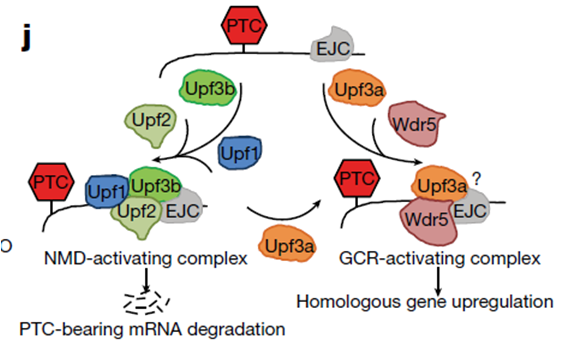Hope for treating genetic disorders via genetic compensation response
A genetic compensation mechanism discovered in zebrafish could open up new prospects in the treatment of genetic disorders, a recent study suggests.
The study by Prof. CHEN Jun from the College of Life Sciences and Prof. PENG Jinrong from the College of Animal Sciences, “PTC-bearing mRNA elicits a genetic compensation response via Upf3a and COMPASS components,” appeared in Nature.
First let’s go back to 2015, in which Prof. PENG’s team has observed phenotypic discrepancies between gene-knockout and gene-knockdown of capn3a, a gene involved in liver development of zebrafish. Small livers are found in zebrafish when the expression of capn3a gene is knocked down, while regular liver development is maintained with the complete knock-out of the same gene. Prof. PENG has suspected this phenomenon is associated with genetic compensation response (GCR), a buffering mechanism that safeguards the body against the loss of gene functions that would otherwise be harmful through upregulation of related genes.
Triggered by this idea, Prof. CHEN and Prof. PENG teamed up and performed a series of genetic and molecular biology experiments to reveal a potential mechanistic basis for the GCR. Key molecules of the GCR, Upf3a (a member of the nonsense-mediated mRNA decay pathway) and components of the COMPASS complex, are revealed in this study.

Proposed model of GCR
By analyzing six uniquely designed transgenes, CHEN & PENG et al.demonstrate that the activation of GCR is dependent on the simultaneous presence of a mRNA bearing a premature termination codon (PTC) and the nucleotide sequence of the transgene mRNA, which is homologous to the compensatory endogenous genes. They show enhancement of epigenetic modification is also observed during the process.
Genome sequencing results show that there are many homozygous genes carrying nonsense mutations in normal populations. Missense mutations of these genes may cause serious human genetic diseases, such as Parkinson's, leukemia, scoliosis. Prof. CHEN speculated that GCR may lead to these diseases. “This study may help lead to the development of therapeutic strategies that treat missense mutations associated with genetic disorders by either creating a PTC in the mutated gene or introducing a transgene containing a PTC to trigger a GCR,” he said.
